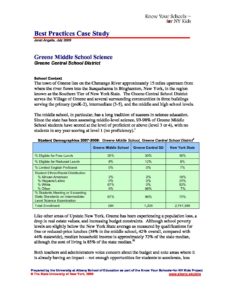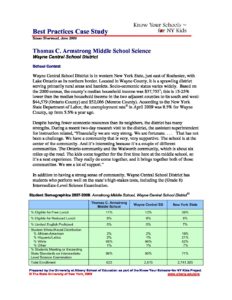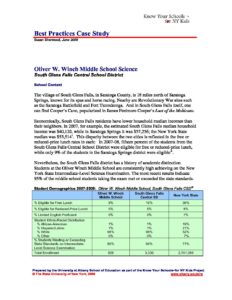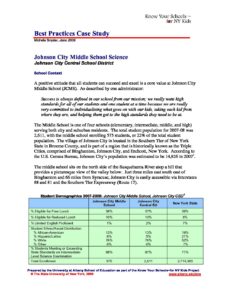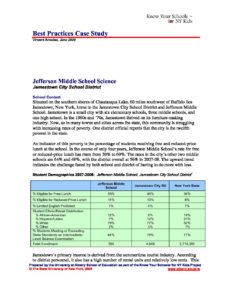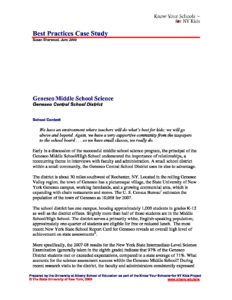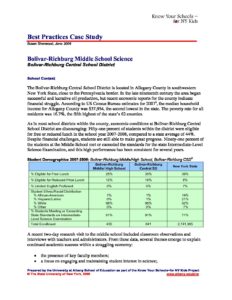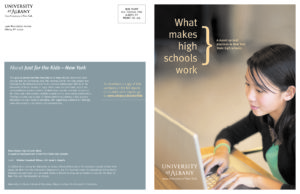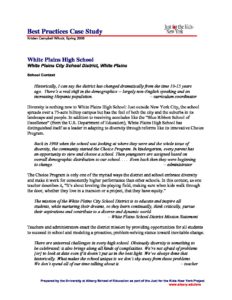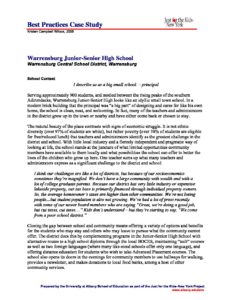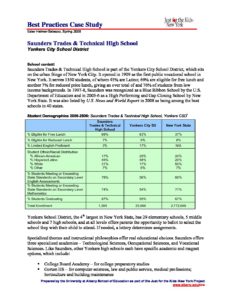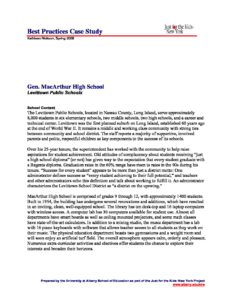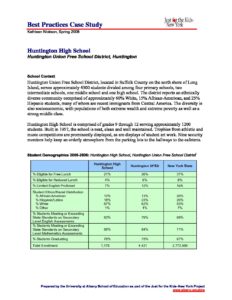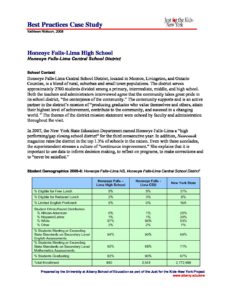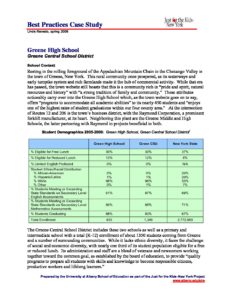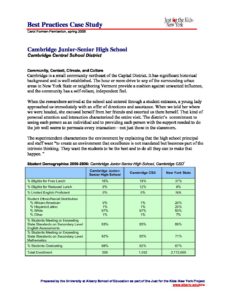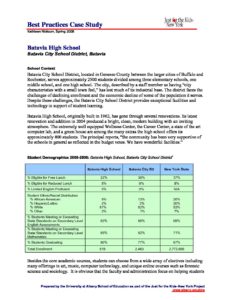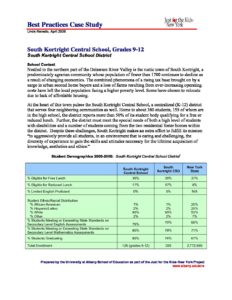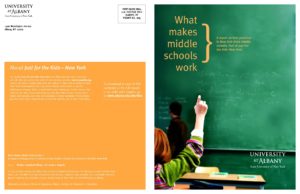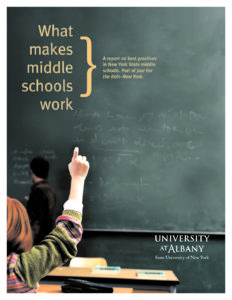A primary activity of NYKids is to conduct research and identify promising practices in odds-beating schools.
Results of each study are available in multiple formats and include reports that summarize the results of each study; best practice frameworks that offer comparisons of higher- and typically-performing schools and sample documents from the odds-beating performers; and case studies of the individual higher-performing, odds-beating schools studied.
Apply Any Combination of Filters to Refine Your Results
Filters
Search Results (195)
This presentation offers best practices across higher performing schools (elementary, middle and high). Key findings include that higher performing schools embrace a variety of data and culture of continuous improvement.
This presentation offers best practices across higher performing schools (elementary, middle and high). Key findings include that higher performing schools embrace a variety of data and culture of continuous improvement.
This case study is part of an investigation of middle school science conducted in the 2008-2009 school year.
This case study was conducted in spring 2009 as one of a series of studies conducted by Just for the Kids~New York since 2005. For the study of middle school science, research teams investigated seven consistently higher-performing and three average-performing schools based on student performance on the New York State Intermediate-Level Science Examination in 2006, 2007, and 2008. Researchers used site-based interviews of teachers and administrators, as well as classroom observations and analyses of supportive documentations, to determine differences in practices between higher- and average-performing schools in the sample.
This case study is part of an investigation of middle school science conducted in the 2008-2009 school year.
This case study was conducted in spring 2009 as one of a series of studies conducted by Just for the Kids~New York since 2005. For the study of middle school science, research teams investigated seven consistently higher-performing and three average-performing schools based on student performance on the New York State Intermediate-Level Science Examination in 2006, 2007, and 2008. Researchers used site-based interviews of teachers and administrators, as well as classroom observations and analyses of supportive documentations, to determine differences in practices between higher- and average-performing schools in the sample.
This case study is part of an investigation of middle school science conducted in the 2008-2009 school year.
This case study was conducted in spring 2009 as one of a series of studies conducted by Just for the Kids~New York since 2005. For the study of middle school science, research teams investigated seven consistently higher-performing and three average-performing schools based on student performance on the New York State Intermediate-Level Science Examination in 2006, 2007, and 2008. Researchers used site-based interviews of teachers and administrators, as well as classroom observations and analyses of supportive documentations, to determine differences in practices between higher- and average-performing schools in the sample.
This case study is part of an investigation of middle school science conducted in the 2008-2009 school year.
This case study was conducted in spring 2009 as one of a series of studies conducted by Just for the Kids~New York since 2005. For the study of middle school science, research teams investigated seven consistently higher-performing and three average-performing schools based on student performance on the New York State Intermediate-Level Science Examination in 2006, 2007, and 2008. Researchers used site-based interviews of teachers and administrators, as well as classroom observations and analyses of supportive documentations, to determine differences in practices between higher- and average-performing schools in the sample.
This case study is part of an investigation of middle school science conducted in the 2008-2009 school year.
This case study was conducted in spring 2009 as one of a series of studies conducted by Just for the Kids~New York since 2005. For the study of middle school science, research teams investigated seven consistently higher-performing and three average-performing schools based on student performance on the New York State Intermediate-Level Science Examination in 2006, 2007, and 2008. Researchers used site-based interviews of teachers and administrators, as well as classroom observations and analyses of supportive documentations, to determine differences in practices between higher- and average-performing schools in the sample.
This case study is part of an investigation of middle school science conducted in the 2008-2009 school year.
This case study was conducted in spring 2009 as one of a series of studies conducted by Just for the Kids~New York since 2005. For the study of middle school science, research teams investigated seven consistently higher-performing and three average-performing schools based on student performance on the New York State Intermediate-Level Science Examination in 2006, 2007, and 2008. Researchers used site-based interviews of teachers and administrators, as well as classroom observations and analyses of supportive documentations, to determine differences in practices between higher- and average-performing schools in the sample.
This case study is part of an investigation of middle school science conducted in the 2008-2009 school year.
This case study was conducted in spring 2009 as one of a series of studies conducted by Just for the Kids~New York since 2005. For the study of middle school science, research teams investigated seven consistently higher-performing and three average-performing schools based on student performance on the New York State Intermediate-Level Science Examination in 2006, 2007, and 2008. Researchers used site-based interviews of teachers and administrators, as well as classroom observations and analyses of supportive documentations, to determine differences in practices between higher- and average-performing schools in the sample.
This presentation discusses the best practice research findings from a study of middle schools. It also offers free resources to inform continuous school improvement efforts in the future.
This presentation discusses the best practice research findings from a study of middle schools. It also offers free resources to inform continuous school improvement efforts in the future.
School improvement practices for middle and high schools.
School improvement practices for middle and high schools. Trusting and respectful relationships found to be key as well as social/emotional wellbeing, team work, evidence-based decision making, and shared vision of mission and goals.
This is an investigation of high schools conducted during the 2007-08 school year.
This case study is one of 10 produced as part of a larger study of high schools conducted during the 2007-08 school year. Research teams investigated 10 consistently higher-performing and five average-performing high schools based on student performance on New York State Assessments of English, mathematics, science, and history. Researchers used site-based interviews of teachers and administrators, as well as analyses of supportive documentation, to determine differences in practices between higher-and average-performing schools in the sample.
This is an investigation of high schools conducted during the 2007-08 school year.
This case study is one of 10 produced as part of a larger study of high schools conducted during the 2007-08 school year. Research teams investigated 10 consistently higher-performing and five average-performing high schools based on student performance on New York State Assessments of English, mathematics, science, and history. Researchers used site-based interviews of teachers and administrators, as well as analyses of supportive documentation, to determine differences in practices between higher-and average-performing schools in the sample.
This case study is one of 10 produced as part of a larger study of high schools conducted during the 2007-08 school year.
This case study is one of 10 produced as part of a larger study of high schools conducted during the 2007-08 school year. Research teams investigated 10 consistently higher-performing and five average-performing high schools based on student performance on New York State Assessments of English, mathematics, science, and history. Researchers used site-based interviews of teachers and administrators, as well as analyses of supportive documentation, to determine differences in practices between higher-and average-performing schools in the sample.
This case study is one of 10 produced as part of a larger study of high schools conducted during the 2007-08 school year.
This case study is one of 10 produced as part of a larger study of high schools conducted during the 2007-08 school year. Research teams investigated 10 consistently higher-performing and five average-performing high schools based on student performance on New York State Assessments of English, mathematics, science, and history. Researchers used site-based interviews of teachers and administrators, as well as analyses of supportive documentation, to determine differences in practices between higher-and average-performing schools in the sample.
This case study is one of 10 produced as part of a larger study of high schools conducted during the 2007-08 school year.
This case study is one of 10 produced as part of a larger study of high schools conducted during the 2007-08 school year. Research teams investigated 10 consistently higher-performing and five average-performing high schools based on student performance on New York State Assessments of English, mathematics, science, and history. Researchers used site-based interviews of teachers and administrators, as well as analyses of supportive documentation, to determine differences in practices between higher-and average-performing schools in the sample.
This case study is one of 10 produced as part of a larger study of high schools conducted during the 2007-08 school year.
This case study is one of 10 produced as part of a larger study of high schools conducted during the 2007-08 school year. Research teams investigated 10 consistently higher-performing and five average-performing high schools based on student performance on New York State Assessments of English, mathematics, science, and history. Researchers used site-based interviews of teachers and administrators, as well as analyses of supportive documentation, to determine differences in practices between higher-and average-performing schools in the sample.
This case study is one of 10 produced as part of a larger study of high schools conducted during the 2007-08 school year.
This case study is one of 10 produced as part of a larger study of high schools conducted during the 2007-08 school year. Research teams investigated 10 consistently higher-performing and five average-performing high schools based on student performance on New York State Assessments of English, mathematics, science, and history. Researchers used site-based interviews of teachers and administrators, as well as analyses of supportive documentation, to determine differences in practices between higher-and average-performing schools in the sample.
This case study is one of 10 produced as part of a larger study of high schools conducted during the 2007-08 school year.
This case study is one of 10 produced as part of a larger study of high schools conducted during the 2007-08 school year. Research teams investigated 10 consistently higher-performing and five average-performing high schools based on student performance on New York State Assessments of English, mathematics, science, and history. Researchers used site-based interviews of teachers and administrators, as well as analyses of supportive documentation, to determine differences in practices between higher-and average-performing schools in the sample.
This case study is one of 10 produced as part of a larger study of high schools conducted during the 2007-08 school year.
This case study is one of 10 produced as part of a larger study of high schools conducted during the 2007-08 school year. Research teams investigated 10 consistently higher-performing and five average-performing high schools based on student performance on New York State Assessments of English, mathematics, science, and history. Researchers used site-based interviews of teachers and administrators, as well as analyses of supportive documentation, to determine differences in practices between higher-and average-performing schools in the sample.
This case study is one of 10 produced as part of a larger study of high schools conducted during the 2007-08 school year.
This case study is one of 10 produced as part of a larger study of high schools conducted during the 2007-08 school year. Research teams investigated 10 consistently higher-performing and five average-performing high schools based on student performance on New York State Assessments of English, mathematics, science, and history. Researchers used site-based interviews of teachers and administrators, as well as analyses of supportive documentation, to determine differences in practices between higher-and average-performing schools in the sample.
This case study is one of 10 produced as part of a larger study of high schools conducted during the 2007-08 school year.
This case study is one of 10 produced as part of a larger study of high schools conducted during the 2007-08 school year. Research teams investigated 10 consistently higher-performing and five average-performing high schools based on student performance on New York State Assessments of English, mathematics, science, and history. Researchers used site-based interviews of teachers and administrators, as well as analyses of supportive documentation, to determine differences in practices between higher-and average-performing schools in the sample.
This case study is one of 10 produced as part of a larger study of high schools conducted during the 2007-08 school year.
This case study is one of 10 produced as part of a larger study of high schools conducted during the 2007-08 school year. Research teams investigated 10 consistently higher-performing and five average-performing high schools based on student performance on New York State Assessments of English, mathematics, science, and history. Researchers used site-based interviews of teachers and administrators, as well as analyses of supportive documentation, to determine differences in practices between higher-and average-performing schools in the sample.
School improvement practices for middle schools.
School improvement practices for middle schools. Findings include: (1) culture supports a vision of high achievement; (2) climate of respect helps enact vision; (3) structure reinforce collaboratively supported; and (4) leadership encourages teacher initiative taking.
This study is comprised of 10 case studies of middle schools conducted during the 2006-07 school year.
Research teams investigated 10 consistently higher-performing and six average-performing middle schools on student performance in New York State Assessments of 8th grade English Language Arts and Mathematics. Researchers used site-based interviews of teachers and administrators, as well as the analysis of supportive documentation, to determine differences in practice between higher- and average-performing schools in the sample. In half the higher-performing schools, poverty levels meet or exceed the state average (as measured by the percent of students receiving free or reduced lunch). Average-performing schools were matched as closely as possible to the higher performers in terms of student poverty levels, geographic location, size, and student ethnicity. Results were organized along five broad themes that form the framework of the national Just for the Kids Study of which the New York study is part. The national study is sponsored by the National Center for Educational Accountability.
This study is comprised of 10 case studies of middle schools conducted during the 2006-07 school year.
Research teams investigated 10 consistently higher-performing and six average-performing middle schools on student performance in New York State Assessments of 8th grade English Language Arts and Mathematics. Researchers used site-based interviews of teachers and administrators, as well as the analysis of supportive documentation, to determine differences in practice between higher- and average-performing schools in the sample. In half the higher-performing schools, poverty levels meet or exceed the state average (as measured by the percent of students receiving free or reduced lunch). Average-performing schools were matched as closely as possible to the higher performers in terms of student poverty levels, geographic location, size, and student ethnicity. Results were organized along five broad themes that form the framework of the national Just for the Kids Study of which the New York study is part. The national study is sponsored by the National Center for Educational Accountability.

